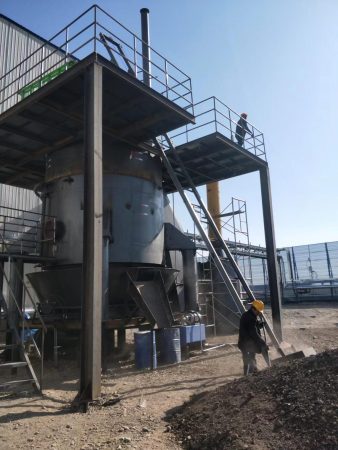Biomass gasifier manufacturers tell you that the reaction processes of different biomass are also different.
Common biomass gasifier reactions can be divided into oxidation layer, reduction layer, cracking layer and drying layer.
The oxidation zone and the reduction zone are collectively called the gasification zone,
and the gasification reaction mainly occurs in the gasification zone.
The cracking zone and drying zone are collectively referred to as the fuel preparation zone.
In recent years, biomass gasifier technology has developed rapidly,
and various forms of biomass gasifiers have developed rapidly,
which are divided into fixed bed gasifiers and fluidized bed gasifiers.
Fixed bed gasifiers are divided into suction type, suction type,
horizontal type and happy type.
When the low-temperature gasifier operates under slight negative pressure,
the sealing requirements are not high,
the gas output heat is high, and the tar content is small,
but the ash content in the gas is large and the temperature of the gas tank is high.
The positive pressure operation of the upper aspirator is small, the sealing requirements are high,
and the tar content in the gas is high.
The furnace temperature of the fluidized bed gasifier is high and constant.
High-temperature tar decomposes to produce gas.
The gas contains less tar but has a large gas content.
The structure of the fluidized bed gasifier is complex, the equipment investment is large,
and the scale of the gasification equipment is large.
The biomass gasifier manufacturer tells you the structure of the biomass gasifier.
This gasifier integrates biomass gasification and tar catalytic cracking,
eliminating the need to provide a heat source for catalytic cracking,
simplifying gas production equipment, and improving energy utilization.
There are three cylinders on the shaft,
which are used in the biomass gasification zone and the catalytic cracking zone respectively.
Put the biomass material into the hopper, and the rotary valve rotates under the action of the motor.
The material falls into the sliding plate in the furnace, slides down layer by layer,
and then falls to the bottom of the furnace body.
After the material in the furnace enters a certain amount,
the material is ignited from the side window of the furnace body,
and the induced draft fan is started,
so that the gas in the furnace moves upward along the two gaps from the lower part of the furnace body,
and enters the catalytic cracking zone through the filter layer.
Part of the gas discharged from the gas pipe is returned by the exhaust fan,
air volume control valve,
lame arrester, and mixed air ignition and sent to the coil heating gasifier,
and finally becomes exhaust gas and is discharged;
the other part is the gas extracted from the blower through the heat exchanger Collected as gas.
The ash is discharged from the bottom through a continuous ash discharge device.
The biomass gasifier manufacturer tells you the structure of the biomass gasifier:
the biomass gasifier integrates biomass gasification and tar catalytic cracking.
It does not need to provide a heat source for catalytic cracking,
simplifies gas production equipment, and improves energy utilization.
There are three cylinders on the shaft,
which are used in the biomass gasification zone and the catalytic cracking zone respectively.
ut the biomass material into the hopper, and the rotary valve rotates under the action of the motor.
The material falls into the sliding plate in the furnace, slides down layer by layer,
and then falls to the bottom of the furnace body.
After the material in the furnace enters a certain amount,
the material is ignited from the side window of the furnace body,
and the induced draft fan is started,
so that the gas in the furnace moves upward along the two gaps from the lower part of the furnace body,
and enters the catalytic cracking zone through the filter layer.
Part of the gas discharged from the gas pipe is sent to the coil heating gasification furnace
through the exhaust fan return air, air volume control valve, flame arrester, and mixed air ignition,
and finally forms waste gas and is discharged; the other part is discharged
through the heat exchanger and the blower as Gas collection.
The ash is discharged from the bottom through a continuous ash discharge device.


